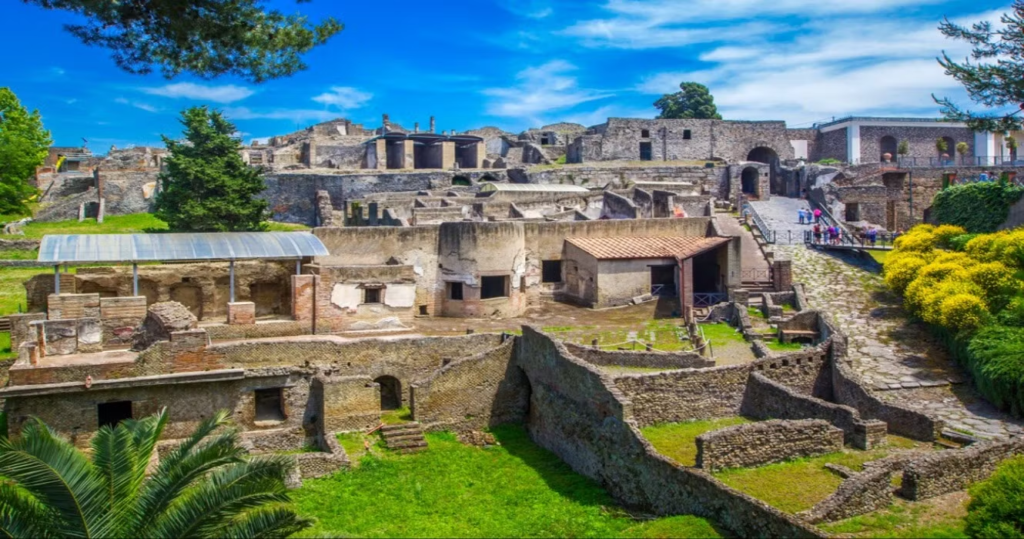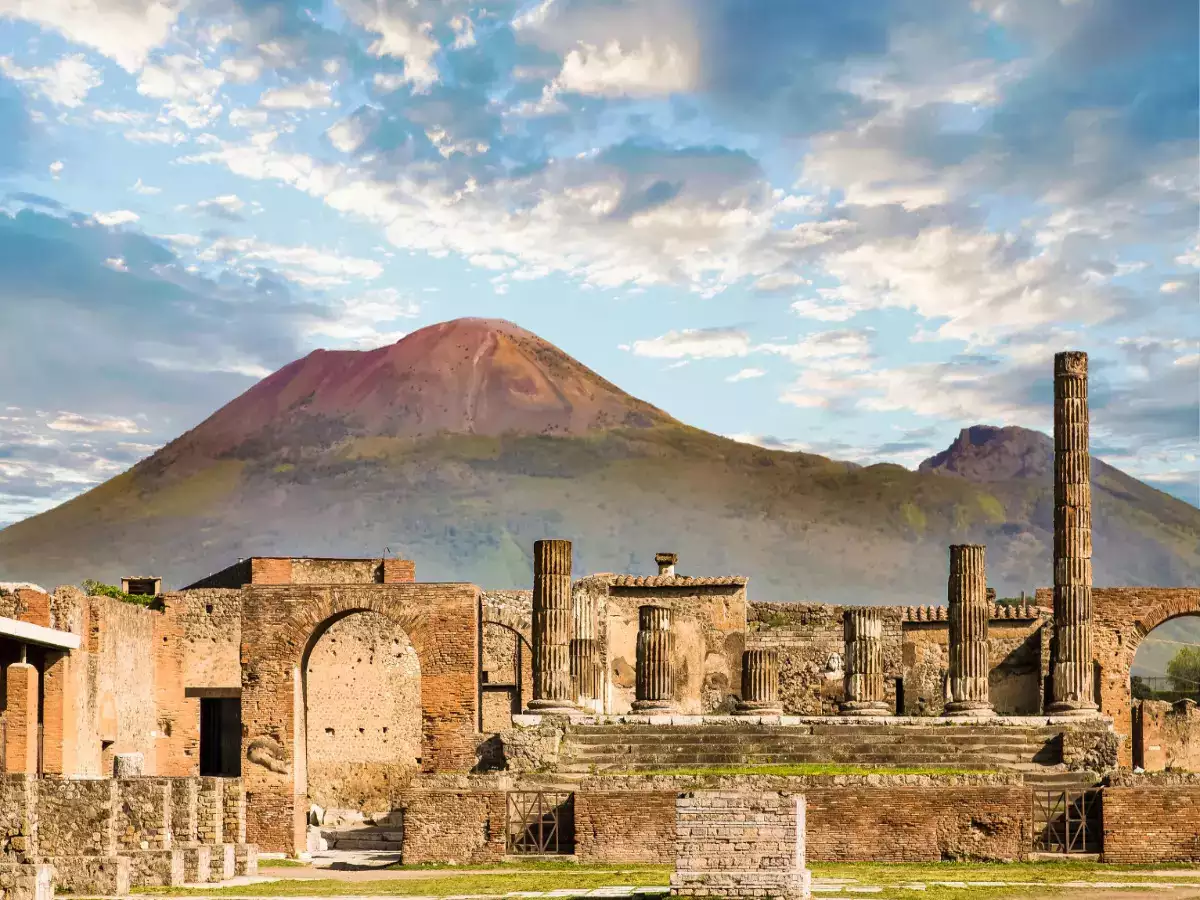Pompeii stands as one of the most fascinating and tragic archaeological sites in the world, offering us a rare and detailed glimpse into ancient Roman life. Situated near modern-day Naples, Italy, this city was once a bustling hub of commerce, culture, and architecture until it was abruptly buried under volcanic ash in 79 AD.
Mount Vesuvius, the volcano responsible for this catastrophe, erupted with such force that the city was entombed in layers of ash and pumice, preserving its buildings, artifacts, and even its people in a remarkable state. Today, this city serves as a poignant reminder of nature’s power and the fragility of human life, drawing millions of visitors each year.
The Rise of Pompeii: A Flourishing Roman City
Pompeii’s history dates back centuries before the Roman Empire, believed to have been founded around the 7th or 6th century BCE by the Osci or Oscan people of central Italy. Over time, the city evolved from a small settlement to a thriving urban center as it came under Greek, Etruscan, and eventually Roman influence.
Situated on the Bay of Naples, this city enjoyed an advantageous location for trade, with easy access to goods from across the Mediterranean. It became a vibrant city where merchants, artisans, and wealthy citizens coexisted, contributing to a flourishing economy and a rich cultural life.
By the time of its destruction, this city had become a quintessential Roman city, complete with an amphitheater, temples, bathhouses, villas, and markets. Its streets buzzed with activity, and the public spaces were adorned with statues, fountains, and murals that showcased the artistic and architectural prowess of the Romans.
Read : Tiny House Filled with Intricate Artwork Found in Pompeii
Archaeologists have found evidence of advanced urban planning, with streets laid out in a grid pattern and homes connected to a sophisticated plumbing system. The people of Pompeii were largely affluent, enjoying luxuries that included public baths, fine dining establishments, and beautifully decorated villas.
These glimpses into everyday life underscore the high standard of living in this city, marking it as a significant historical and cultural hub of the ancient Roman world.
The Catastrophic Eruption of Mount Vesuvius
The tranquil life in Pompeii came to an end on August 24, 79 AD, when Mount Vesuvius erupted violently. Though the eruption was sudden, there were warning signs leading up to the event. Residents experienced minor earthquakes, which were common in the area and often went unnoticed or ignored.
However, the eruption that followed was unprecedented in its ferocity. Spewing ash, lava, and toxic gases miles into the sky, Vesuvius unleashed a force capable of wiping out the entire city within hours. The people of Pompeii had little time to react, with the initial eruption catching many off-guard.
Pompeii seen from a drone
— Massimo (@Rainmaker1973) November 7, 2024
[📹 pompeii_parco_archeologico]pic.twitter.com/rcKtge9Zeg
The eruption continued for nearly 18 hours, blanketing this city in up to 20 feet of volcanic ash and pumice. The air became thick with sulfur, making it impossible for people to breathe, and buildings collapsed under the weight of the ash. Many of Pompeii’s residents tried to flee, while others sought refuge in their homes, hoping the danger would pass.
Tragically, most were overwhelmed by the pyroclastic flows—a deadly mix of hot gases, lava fragments, and volcanic debris—that swept through the city at high speeds, incinerating everything in their path. In total, an estimated 16,000 people perished as a result of the eruption, and Pompeii was left buried and abandoned.
The ash and pumice, however, played an unintended role in preserving Pompeii. Organic materials that would have otherwise decayed over time were shielded from air and moisture, creating an eerily intact snapshot of ancient life.
This phenomenon of preservation has allowed archaeologists to uncover remarkable details about the daily lives of Pompeii’s inhabitants, from their diet and occupations to their social structures and religious practices.
Rediscovery and Excavation: Unearthing Pompeii’s Hidden Treasures
For centuries, this city lay forgotten, buried beneath layers of ash and vegetation. It wasn’t until 1599, when an architect named Domenico Fontana stumbled upon some ruins while constructing an underground water channel, that interest in the site was rekindled.
However, it wasn’t until 1748, under the reign of King Charles III of Spain, that systematic excavations began, revealing Pompeii’s hidden treasures to the world. These early excavations were rudimentary by modern standards, with many artifacts removed and sometimes damaged in the process.

Over time, however, archaeological methods improved, allowing for more careful excavation and preservation of Pompeii’s ruins. The city’s buildings, frescoes, pottery, jewelry, and even graffiti were unearthed, providing an unprecedented glimpse into Roman civilization.
One of the most striking discoveries was the plaster casts of Pompeii’s inhabitants, which were created by filling the hollow spaces left by decomposed bodies with plaster.
These casts show the final moments of people who died in the disaster, frozen in expressions of fear and desperation. They are a haunting reminder of the human cost of the eruption and lend a powerful sense of realism to Pompeii’s story.
Excavations continue to this day, revealing new facets of Pompeii’s complex history and culture. Archaeologists have uncovered everything from well-preserved frescoes and mosaics to ancient fast-food stands, offering insights into the diet and dining habits of the city’s residents.
The Forum, temples, theaters, and private homes with elaborate decorations speak to Pompeii’s social structure and the artistic achievements of its people. Every artifact tells a story, helping historians piece together a narrative of a society that was both sophisticated and deeply connected to the Roman Empire.
Pompeii’s Legacy: Lessons and Insights from the Past
Pompeii is more than just an archaeological wonder; it is a testament to human resilience, curiosity, and the pursuit of knowledge. The site offers invaluable insights into Roman culture, architecture, and urban life, serving as a “time capsule” that has educated generations of scholars and enthusiasts.
From the meticulous planning of its streets to the artistry of its frescoes, Pompeii has helped us understand the intricacies of ancient Roman society, shedding light on their beliefs, values, and customs.

Beyond its historical and cultural significance, This city also serves as a stark reminder of nature’s unpredictable power. Mount Vesuvius remains an active volcano, and the region around it is still vulnerable to future eruptions. In fact, the area is home to millions of people today, including the cities of Naples and Herculaneum, which face similar risks.
The story of Pompeii underscores the importance of disaster preparedness and the need to respect the forces of nature. As modern technology advances, scientists are better able to monitor volcanic activity, yet the lessons from Pompeii remind us of the limitations of human control over the natural world.
Today, Pompeii is a UNESCO World Heritage Site and one of Italy’s most popular tourist destinations. Visitors from around the world come to walk its ancient streets, view its murals, and imagine life as it was nearly two millennia ago.
The preservation of Pompeii allows people to connect with a bygone era in a tangible way, making history feel alive and relevant. The city continues to captivate and inspire, reminding us of both the achievements and vulnerabilities of human civilization.
let’s enjoy few years on earth with peace and happiness….✍🏼🙏

